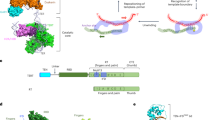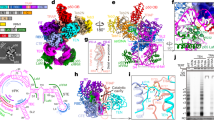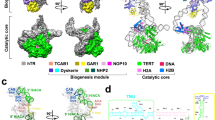Abstract
Telomerase is a ribonucleoprotein (RNP) enzyme that maintains the ends of linear eukaryotic chromosomes and whose activation is a hallmark of 90% of all cancers. This RNP minimally contains a reverse transcriptase protein subunit (TERT) that catalyzes telomeric DNA synthesis and an RNA subunit (TER) that has templating, architectural and protein-scaffolding roles. Telomerase is unique among polymerases in that it synthesizes multiple copies of the template on the 3′ end of a primer following a single binding event, a process known as repeat addition processivity (RAP). Using biochemical assays and single-molecule Förster resonance energy transfer (smFRET) experiments on Tetrahymena thermophila telomerase, we now directly demonstrate that TER contributes to template positioning within the active site and to the template translocation required for RAP. We propose that the single-stranded RNA elements flanking the template act as a molecular accordion, undergoing reciprocal extension and compaction during telomerase translocation.
This is a preview of subscription content, access via your institution
Access options
Subscribe to this journal
Receive 12 print issues and online access
$189.00 per year
only $15.75 per issue
Buy this article
- Purchase on Springer Link
- Instant access to full article PDF
Prices may be subject to local taxes which are calculated during checkout




Similar content being viewed by others
References
Greider, C.W. & Blackburn, E.H. The telomere terminal transferase of Tetrahymena is a ribonucleoprotein enzyme with two kinds of primer specificity. Cell 51, 887–898 (1987).
Lingner, J. et al. Reverse transcriptase motifs in the catalytic subunit of telomerase. Science 276, 561–567 (1997).
Romero, D.P. & Blackburn, E.H. A conserved secondary structure for telomerase RNA. Cell 67, 343–353 (1991).
Chen, J.L., Blasco, M.A. & Greider, C.W. Secondary structure of vertebrate telomerase RNA. Cell 100, 503–514 (2000).
ten Dam, E., van Belkum, A. & Pleij, K. A conserved pseudoknot in telomerase RNA. Nucleic Acids Res. 19, 6951 (1991).
Chen, J.L. & Greider, C.W. An emerging consensus for telomerase RNA structure. Proc. Natl. Acad. Sci. USA 101, 14683–14684 (2004).
Tzfati, Y., Fulton, T.B., Roy, J. & Blackburn, E.H. Template boundary in a yeast telomerase specified by RNA structure. Science 288, 863–867 (2000).
Autexier, C. & Greider, C.W. Boundary elements of the Tetrahymena telomerase RNA template and alignment domains. Genes Dev. 9, 2227–2239 (1995).
Gilley, D. & Blackburn, E.H. Specific RNA residue interactions required for enzymatic functions of Tetrahymena telomerase. Mol. Cell. Biol. 16, 66–75 (1996).
Licht, J.D. & Collins, K. Telomerase RNA function in recombinant Tetrahymena telomerase. Genes Dev. 13, 1116–1125 (1999).
Shefer, K. et al. A triple helix within a pseudoknot is a conserved and essential element of telomerase RNA. Mol. Cell. Biol. 27, 2130–2143 (2007).
Theimer, C.A., Blois, C.A. & Feigon, J. Structure of the human telomerase RNA pseudoknot reveals conserved tertiary interactions essential for function. Mol. Cell 17, 671–682 (2005).
Tzfati, Y., Knight, Z., Roy, J. & Blackburn, E.H. A novel pseudoknot element is essential for the action of a yeast telomerase. Genes Dev. 17, 1779–1788 (2003).
Mason, D.X., Goneska, E. & Greider, C.W. Stem-loop IV of Tetrahymena telomerase RNA stimulates processivity in trans. Mol. Cell. Biol. 23, 5606–5613 (2003).
Miller, M.C. & Collins, K. Telomerase recognizes its template by using an adjacent RNA motif. Proc. Natl. Acad. Sci. USA 99, 6585–6590 (2002).
Berman, A.J., Gooding, A.R. & Cech, T.R. Tetrahymena telomerase protein p65 induces conformational changes throughout telomerase RNA (TER) and rescues telomerase reverse transcriptase and TER assembly mutants. Mol. Cell. Biol. 30, 4965–4976 (2010).
Lai, C.K., Miller, M.C. & Collins, K. Template boundary definition in Tetrahymena telomerase. Genes Dev. 16, 415–420 (2002).
Chen, J.L. & Greider, C.W. Template boundary definition in mammalian telomerase. Genes Dev. 17, 2747–2752 (2003).
Stone, M.D. et al. Stepwise protein-mediated RNA folding directs assembly of telomerase ribonucleoprotein. Nature 446, 458–461 (2007).
Witkin, K.L. & Collins, K. Holoenzyme proteins required for the physiological assembly and activity of telomerase. Genes Dev. 18, 1107–1118 (2004).
O'Connor, C.M., Lai, C.K. & Collins, K. Two purified domains of telomerase reverse transcriptase reconstitute sequence-specific interactions with RNA. J. Biol. Chem. 280, 17533–17539 (2005).
Wu, J.Y., Stone, M.D. & Zhuang, X. A single-molecule assay for telomerase structure-function analysis. Nucleic Acids Res. 38, e16 (2010).
Collins, K. & Gandhi, L. The reverse transcriptase component of the Tetrahymena telomerase ribonucleoprotein complex. Proc. Natl. Acad. Sci. USA 95, 8485–8490 (1998).
Kaushik, N. et al. Biochemical analysis of catalytically crucial aspartate mutants of human immunodeficiency virus type 1 reverse transcriptase. Biochemistry 35, 11536–11546 (1996).
Patel, P.H. et al. Insights into DNA polymerization mechanisms from structure and function analysis of HIV-1 reverse transcriptase. Biochemistry 34, 5351–5363 (1995).
Cheetham, G.M., Jeruzalmi, D. & Steitz, T.A. Transcription regulation, initiation, and 'DNA scrunching' by T7 RNA polymerase. Cold Spring Harb. Symp. Quant. Biol. 63, 263–267 (1998).
Kapanidis, A.N. et al. Initial transcription by RNA polymerase proceeds through a DNA-scrunching mechanism. Science 314, 1144–1147 (2006).
Brieba, L.G. & Sousa, R. T7 promoter release mediated by DNA scrunching. EMBO J. 20, 6826–6835 (2001).
Zaug, A.J., Podell, E.R. & Cech, T.R. Mutation in TERT separates processivity from anchor-site function. Nat. Struct. Mol. Biol. 15, 870–872 (2008).
Förstemann, K. & Lingner, J. Telomerase limits the extent of base pairing between template RNA and telomeric DNA. EMBO Rep. 6, 361–366 (2005).
Hammond, P.W. & Cech, T.R. Euplotes telomerase: evidence for limited base-pairing during primer elongation and dGTP as an effector of translocation. Biochemistry 37, 5162–5172 (1998).
Zaug, A.J. & Cech, T.R. Analysis of the structure of Tetrahymena nuclear RNAs in vivo: telomerase RNA, the self-splicing rRNA intron, and U2 snRNA. RNA 1, 363–374 (1995).
Akiyama, B.M. & Stone, M.D. Assembly of complex RNAs by splinted ligation. Methods Enzymol. 469, 27–46 (2009).
Bryan, T.M., Goodrich, K.J. & Cech, T.R. A mutant of Tetrahymena telomerase reverse transcriptase with increased processivity. J. Biol. Chem. 275, 24199–24207 (2000).
Ha, T. et al. Single-molecule fluorescence spectroscopy of enzyme conformational dynamics and cleavage mechanism. Proc. Natl. Acad. Sci. USA 96, 893–898 (1999).
Roy, R., Hohng, S. & Ha, T. A practical guide to single-molecule FRET. Nat. Methods 5, 507–516 (2008).
Acknowledgements
This work was partially supported by a Jane Coffin Childs Memorial Fund for Medical Research postdoctoral fellowship to A.J.B., US National Institutes of Health grant GM095850 to M.D.S. and US National Institutes of Health training grant T32 GM8646 to B.M.A.
Author information
Authors and Affiliations
Contributions
A.J.B. conducted all biochemical experiments; A.J.B. and T.R.C. designed and analyzed biochemical experiments. B.M.A. conducted smFRET experiments; B.M.A. and M.D.S. designed and analyzed smFRET experiments. All authors participated in writing the manuscript.
Corresponding author
Ethics declarations
Competing interests
The authors declare no competing financial interests.
Supplementary information
Supplementary Text and Figures
Supplementary Figures 1–8 (PDF 5024 kb)
Rights and permissions
About this article
Cite this article
Berman, A., Akiyama, B., Stone, M. et al. The RNA accordion model for template positioning by telomerase RNA during telomeric DNA synthesis. Nat Struct Mol Biol 18, 1371–1375 (2011). https://doi.org/10.1038/nsmb.2174
Received:
Accepted:
Published:
Issue Date:
DOI: https://doi.org/10.1038/nsmb.2174
This article is cited by
-
Single-Molecule Characterization of Cy3.5 -Cy5.5 Dye Pair for FRET Studies of Nucleic Acids and Nucleosomes
Journal of Fluorescence (2023)
-
Structures of telomerase at several steps of telomere repeat synthesis
Nature (2021)
-
Structural basis of template-boundary definition in Tetrahymena telomerase
Nature Structural & Molecular Biology (2015)
-
Protein-RNA interaction restricts telomerase from running through the stop sign
Nature Structural & Molecular Biology (2015)
-
A DNA-hairpin model for repeat-addition processivity in telomere synthesis
Nature Structural & Molecular Biology (2015)



